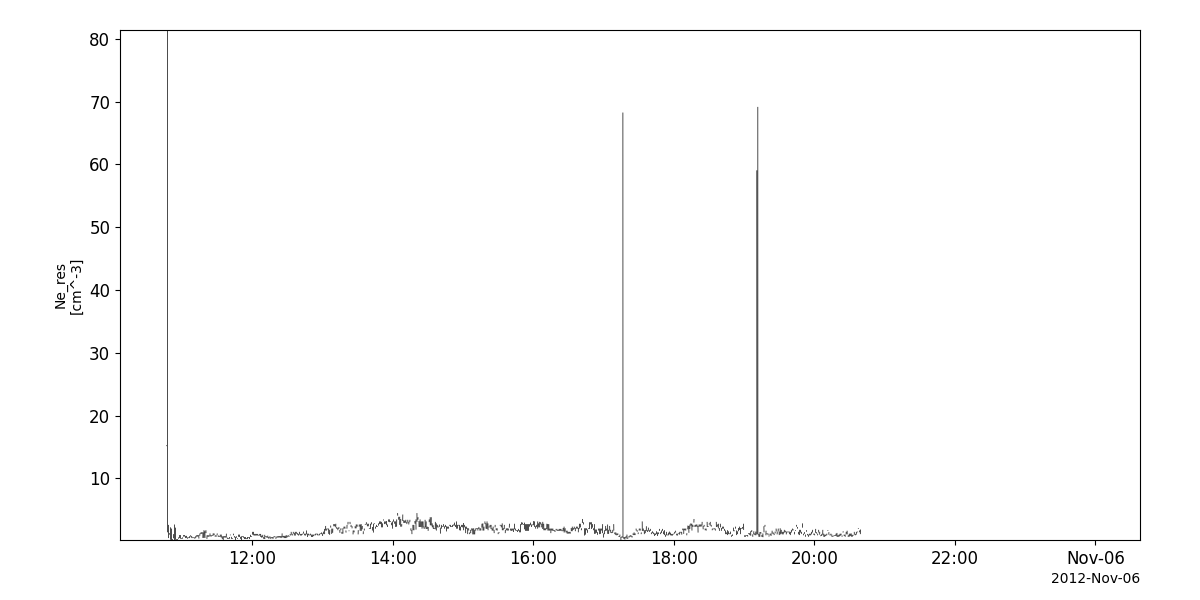Cluster
The routines in this module can be used to load data from the Cluster mission.
Fluxgate Magnetometer (FGM)
- pyspedas.cluster.fgm(trange=['2018-11-5', '2018-11-6'], probe='1', datatype='up', suffix='', get_support_data=False, varformat=None, varnames=[], downloadonly=False, notplot=False, no_update=False, time_clip=False)
This function loads data from the Fluxgate Magnetometer
- Parameters
trange – list of str time range of interest [starttime, endtime] with the format ‘YYYY-MM-DD’,’YYYY-MM-DD’] or to specify more or less than a day [‘YYYY-MM-DD/hh:mm:ss’,’YYYY-MM-DD/hh:mm:ss’]
datatype – str Data type; Valid options:
suffix – str The tplot variable names will be given this suffix. By default, no suffix is added.
get_support_data – bool Data with an attribute “VAR_TYPE” with a value of “support_data” will be loaded into tplot. By default, only loads in data with a “VAR_TYPE” attribute of “data”.
varformat – str The file variable formats to load into tplot. Wildcard character “*” is accepted. By default, all variables are loaded in.
varnames – list of str List of variable names to load (if not specified, all data variables are loaded)
downloadonly – bool Set this flag to download the CDF files, but not load them into tplot variables
notplot – bool Return the data in hash tables instead of creating tplot variables
no_update – bool If set, only load data from your local cache
time_clip – bool Time clip the variables to exactly the range specified in the trange keyword
- Returns
List of tplot variables created.
Example
import pyspedas
from pytplot import tplot
fgm_vars = pyspedas.cluster.fgm(trange=['2018-11-5', '2018-11-6'])
tplot('B_xyz_gse__C1_UP_FGM')
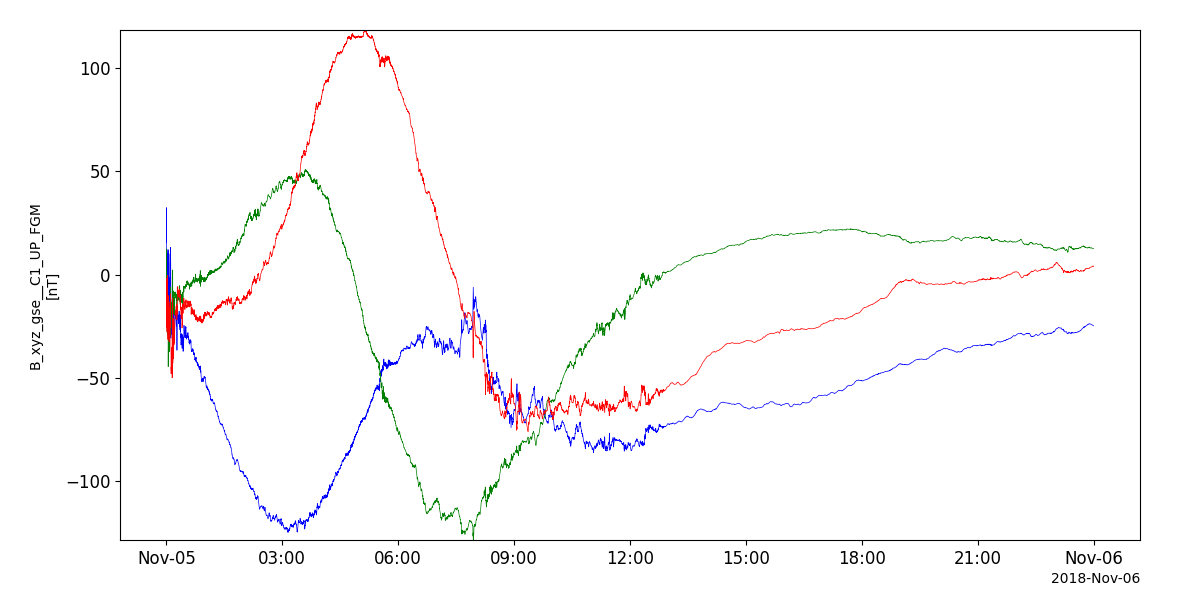
Active Spacecraft Potential Control experiment (ASPOC)
- pyspedas.cluster.aspoc(trange=['2018-11-5', '2018-11-6'], probe='1', datatype='pp', suffix='', get_support_data=False, varformat=None, varnames=[], downloadonly=False, notplot=False, no_update=False, time_clip=False)
This function loads data from the Active Spacecraft Potential Control experiment
- Parameters
trange – list of str time range of interest [starttime, endtime] with the format ‘YYYY-MM-DD’,’YYYY-MM-DD’] or to specify more or less than a day [‘YYYY-MM-DD/hh:mm:ss’,’YYYY-MM-DD/hh:mm:ss’]
datatype – str Data type; Valid options:
suffix – str The tplot variable names will be given this suffix. By default, no suffix is added.
get_support_data – bool Data with an attribute “VAR_TYPE” with a value of “support_data” will be loaded into tplot. By default, only loads in data with a “VAR_TYPE” attribute of “data”.
varformat – str The file variable formats to load into tplot. Wildcard character “*” is accepted. By default, all variables are loaded in.
varnames – list of str List of variable names to load (if not specified, all data variables are loaded)
downloadonly – bool Set this flag to download the CDF files, but not load them into tplot variables
notplot – bool Return the data in hash tables instead of creating tplot variables
no_update – bool If set, only load data from your local cache
time_clip – bool Time clip the variables to exactly the range specified in the trange keyword
- Returns
List of tplot variables created.
Example
import pyspedas
from pytplot import tplot
asp_vars = pyspedas.cluster.aspoc(trange=['2004-10-01', '2004-10-2'])
tplot('I_ion__C1_PP_ASP')
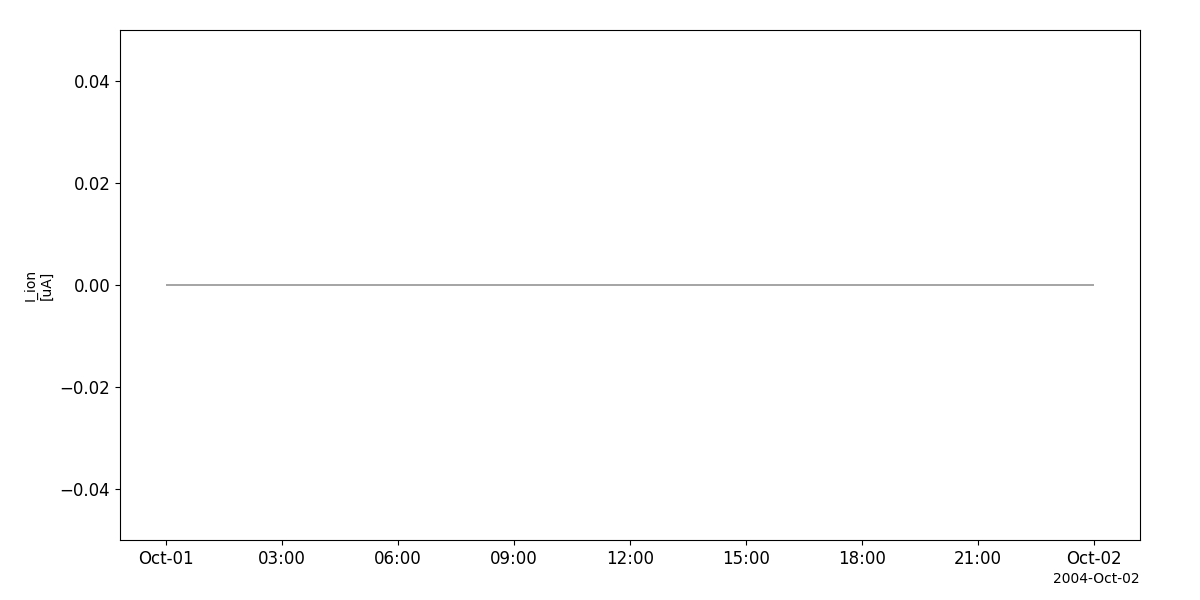
Cluster Ion Spectroscopy experiment (CIS)
- pyspedas.cluster.cis(trange=['2018-11-5', '2018-11-6'], probe='1', datatype='pp', suffix='', get_support_data=False, varformat=None, varnames=[], downloadonly=False, notplot=False, no_update=False, time_clip=False)
This function loads data from the Cluster Ion Spectroscopy experiment
- Parameters
trange – list of str time range of interest [starttime, endtime] with the format ‘YYYY-MM-DD’,’YYYY-MM-DD’] or to specify more or less than a day [‘YYYY-MM-DD/hh:mm:ss’,’YYYY-MM-DD/hh:mm:ss’]
datatype – str Data type; Valid options:
suffix – str The tplot variable names will be given this suffix. By default, no suffix is added.
get_support_data – bool Data with an attribute “VAR_TYPE” with a value of “support_data” will be loaded into tplot. By default, only loads in data with a “VAR_TYPE” attribute of “data”.
varformat – str The file variable formats to load into tplot. Wildcard character “*” is accepted. By default, all variables are loaded in.
varnames – list of str List of variable names to load (if not specified, all data variables are loaded)
downloadonly – bool Set this flag to download the CDF files, but not load them into tplot variables
notplot – bool Return the data in hash tables instead of creating tplot variables
no_update – bool If set, only load data from your local cache
time_clip – bool Time clip the variables to exactly the range specified in the trange keyword
- Returns
List of tplot variables created.
Example
import pyspedas
from pytplot import tplot
cis_vars = pyspedas.cluster.cis(trange=['2004-10-01', '2004-10-2'])
tplot(['N_p__C1_PP_CIS', 'V_p_xyz_gse__C1_PP_CIS', 'T_p_par__C1_PP_CIS', 'T_p_perp__C1_PP_CIS'])
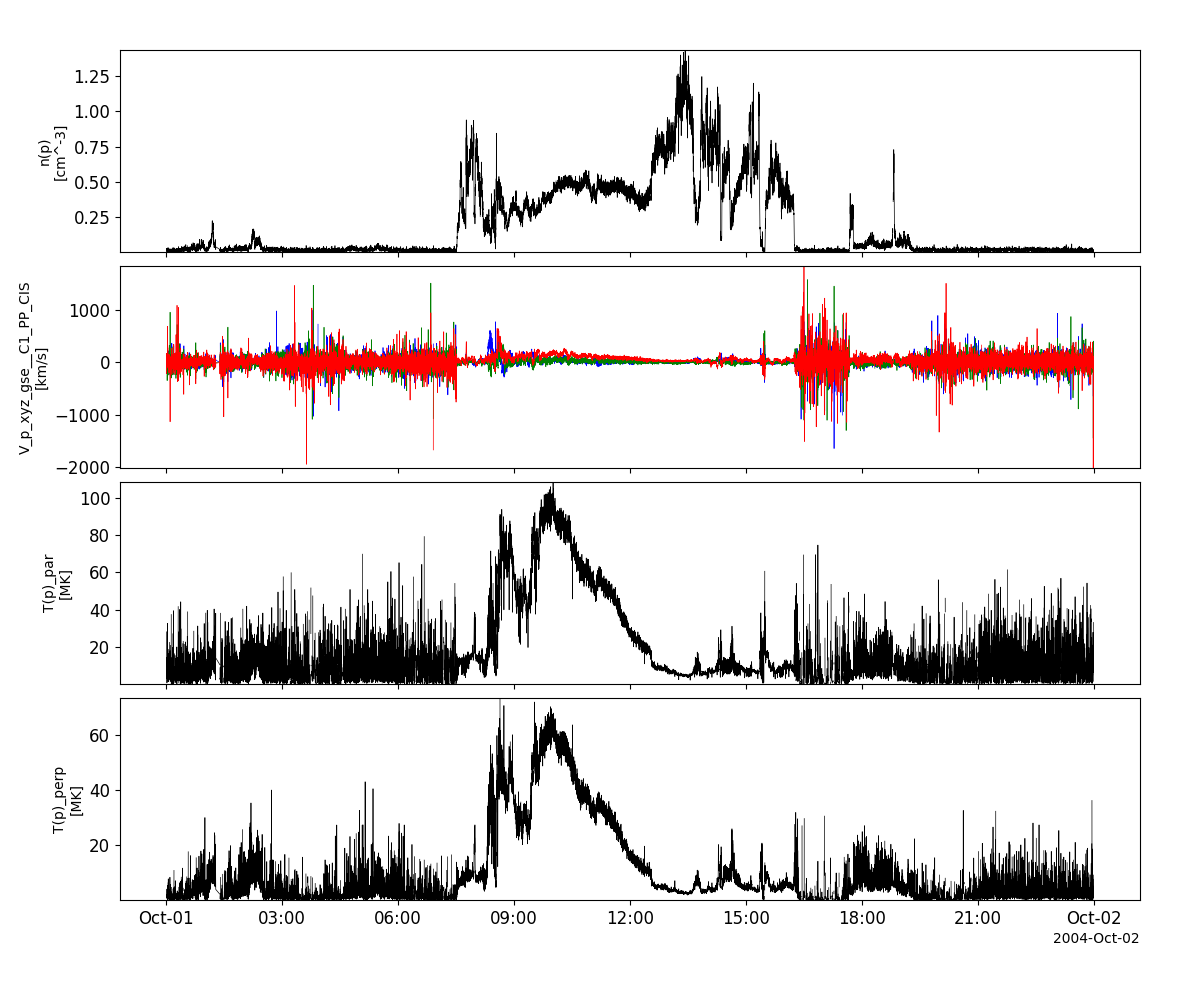
Digital Wave Processing instrument (DWP)
- pyspedas.cluster.dwp(trange=['2018-11-5', '2018-11-6'], probe='1', datatype='pp', suffix='', get_support_data=False, varformat=None, varnames=[], downloadonly=False, notplot=False, no_update=False, time_clip=False)
This function loads data from the Digital Wave Processing instrument
- Parameters
trange – list of str time range of interest [starttime, endtime] with the format ‘YYYY-MM-DD’,’YYYY-MM-DD’] or to specify more or less than a day [‘YYYY-MM-DD/hh:mm:ss’,’YYYY-MM-DD/hh:mm:ss’]
datatype – str Data type; Valid options:
suffix – str The tplot variable names will be given this suffix. By default, no suffix is added.
get_support_data – bool Data with an attribute “VAR_TYPE” with a value of “support_data” will be loaded into tplot. By default, only loads in data with a “VAR_TYPE” attribute of “data”.
varformat – str The file variable formats to load into tplot. Wildcard character “*” is accepted. By default, all variables are loaded in.
varnames – list of str List of variable names to load (if not specified, all data variables are loaded)
downloadonly – bool Set this flag to download the CDF files, but not load them into tplot variables
notplot – bool Return the data in hash tables instead of creating tplot variables
no_update – bool If set, only load data from your local cache
time_clip – bool Time clip the variables to exactly the range specified in the trange keyword
- Returns
List of tplot variables created.
Example
import pyspedas
from pytplot import tplot
dwp_vars = pyspedas.cluster.dwp(trange=['2004-10-01', '2004-10-2'])
tplot('Correl_Ivar__C1_PP_DWP')
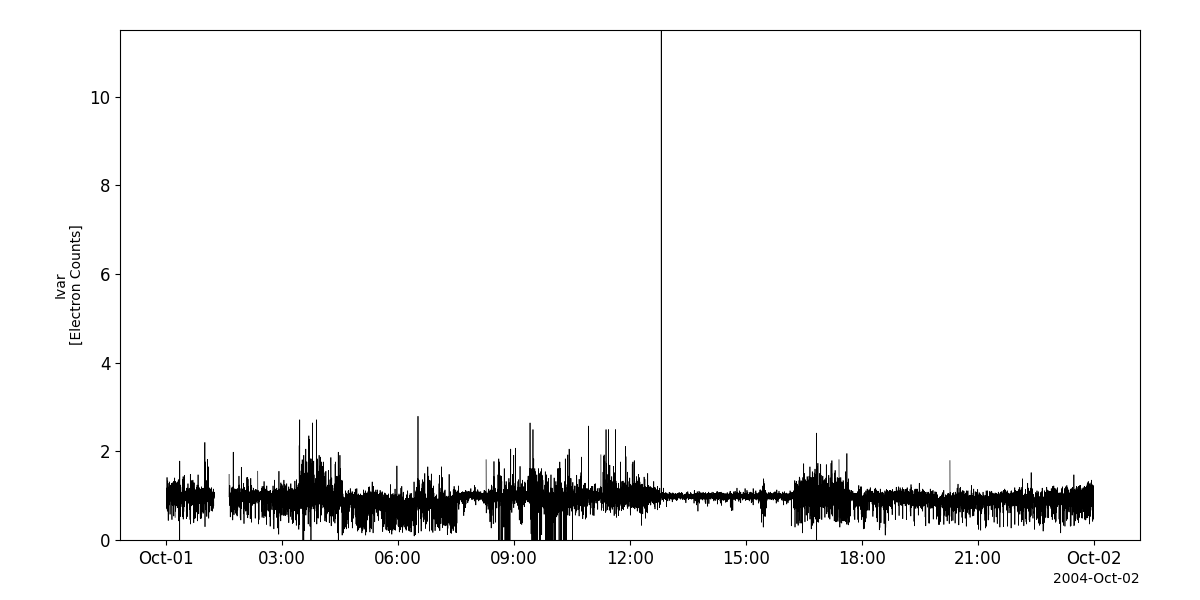
Electron Drift Instrument (EDI)
- pyspedas.cluster.edi(trange=['2018-11-5', '2018-11-6'], probe='1', datatype='pp', suffix='', get_support_data=False, varformat=None, varnames=[], downloadonly=False, notplot=False, no_update=False, time_clip=False)
This function loads data from the Electron Drift Instrument
- Parameters
trange – list of str time range of interest [starttime, endtime] with the format ‘YYYY-MM-DD’,’YYYY-MM-DD’] or to specify more or less than a day [‘YYYY-MM-DD/hh:mm:ss’,’YYYY-MM-DD/hh:mm:ss’]
datatype – str Data type; Valid options:
suffix – str The tplot variable names will be given this suffix. By default, no suffix is added.
get_support_data – bool Data with an attribute “VAR_TYPE” with a value of “support_data” will be loaded into tplot. By default, only loads in data with a “VAR_TYPE” attribute of “data”.
varformat – str The file variable formats to load into tplot. Wildcard character “*” is accepted. By default, all variables are loaded in.
varnames – list of str List of variable names to load (if not specified, all data variables are loaded)
downloadonly – bool Set this flag to download the CDF files, but not load them into tplot variables
notplot – bool Return the data in hash tables instead of creating tplot variables
no_update – bool If set, only load data from your local cache
time_clip – bool Time clip the variables to exactly the range specified in the trange keyword
- Returns
List of tplot variables created.
Example
import pyspedas
from pytplot import tplot
edi_vars = pyspedas.cluster.edi(trange=['2004-10-01', '2004-10-2'])
tplot(['V_ed_xyz_gse__C1_PP_EDI', 'E_xyz_gse__C1_PP_EDI'])
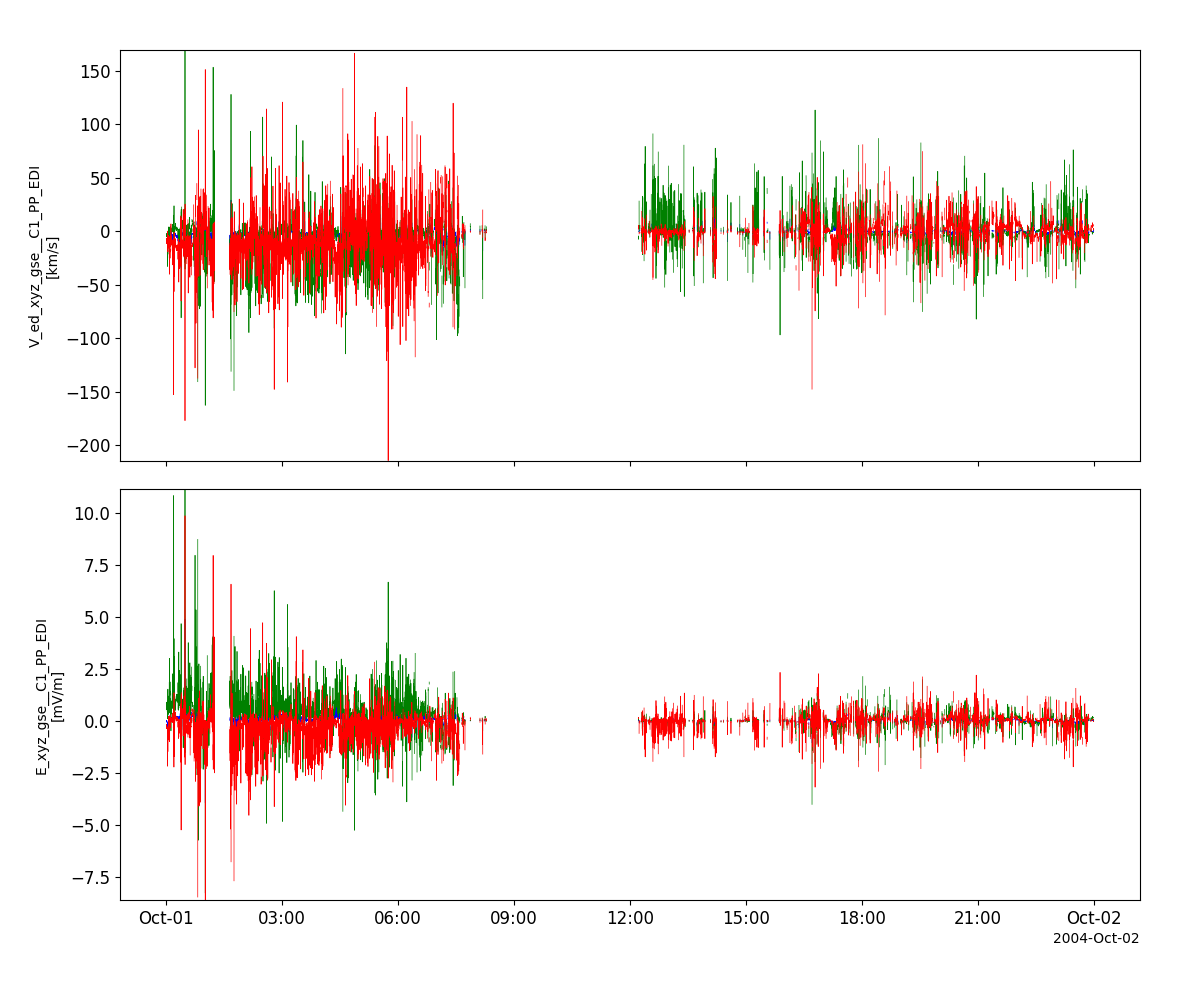
Electric Field and Wave experiment (EFW)
- pyspedas.cluster.efw(trange=['2018-11-5', '2018-11-6'], probe='1', datatype='pp', suffix='', get_support_data=False, varformat=None, varnames=[], downloadonly=False, notplot=False, no_update=False, time_clip=False)
This function loads data from the Electric Field and Wave experiment
- Parameters
trange – list of str time range of interest [starttime, endtime] with the format ‘YYYY-MM-DD’,’YYYY-MM-DD’] or to specify more or less than a day [‘YYYY-MM-DD/hh:mm:ss’,’YYYY-MM-DD/hh:mm:ss’]
datatype – str Data type; Valid options:
suffix – str The tplot variable names will be given this suffix. By default, no suffix is added.
get_support_data – bool Data with an attribute “VAR_TYPE” with a value of “support_data” will be loaded into tplot. By default, only loads in data with a “VAR_TYPE” attribute of “data”.
varformat – str The file variable formats to load into tplot. Wildcard character “*” is accepted. By default, all variables are loaded in.
varnames – list of str List of variable names to load (if not specified, all data variables are loaded)
downloadonly – bool Set this flag to download the CDF files, but not load them into tplot variables
notplot – bool Return the data in hash tables instead of creating tplot variables
no_update – bool If set, only load data from your local cache
time_clip – bool Time clip the variables to exactly the range specified in the trange keyword
- Returns
List of tplot variables created.
Example
import pyspedas
from pytplot import tplot
efw_vars = pyspedas.cluster.efw(trange=['2004-10-01', '2004-10-2'])
tplot('E_dusk__C1_PP_EFW')
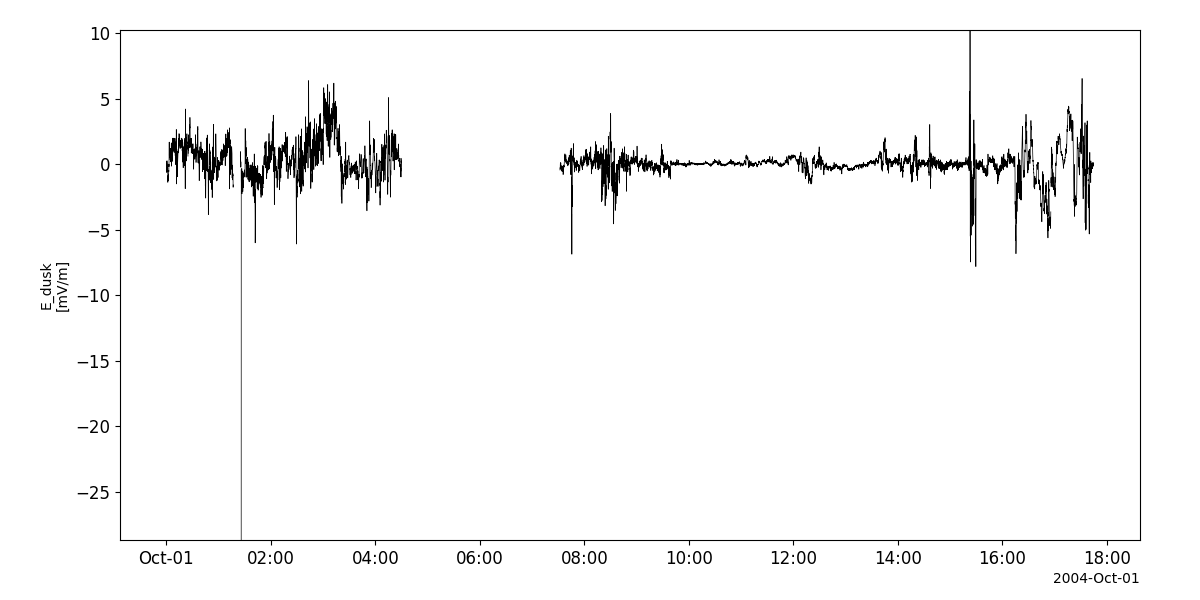
Plasma Electron and Current Experiment (PEACE)
- pyspedas.cluster.peace(trange=['2016-11-5', '2016-11-6'], probe='1', datatype='pp', suffix='', get_support_data=False, varformat=None, varnames=[], downloadonly=False, notplot=False, no_update=False, time_clip=False)
This function loads data from the Plasma Electron and Current Experiment
- Parameters
trange – list of str time range of interest [starttime, endtime] with the format ‘YYYY-MM-DD’,’YYYY-MM-DD’] or to specify more or less than a day [‘YYYY-MM-DD/hh:mm:ss’,’YYYY-MM-DD/hh:mm:ss’]
datatype – str Data type; Valid options:
suffix – str The tplot variable names will be given this suffix. By default, no suffix is added.
get_support_data – bool Data with an attribute “VAR_TYPE” with a value of “support_data” will be loaded into tplot. By default, only loads in data with a “VAR_TYPE” attribute of “data”.
varformat – str The file variable formats to load into tplot. Wildcard character “*” is accepted. By default, all variables are loaded in.
varnames – list of str List of variable names to load (if not specified, all data variables are loaded)
downloadonly – bool Set this flag to download the CDF files, but not load them into tplot variables
notplot – bool Return the data in hash tables instead of creating tplot variables
no_update – bool If set, only load data from your local cache
time_clip – bool Time clip the variables to exactly the range specified in the trange keyword
- Returns
List of tplot variables created.
Example
import pyspedas
from pytplot import tplot
peace_vars = pyspedas.cluster.peace(trange=['2004-10-01', '2004-10-2'])
tplot(['N_e_den__C1_PP_PEA', 'V_e_xyz_gse__C1_PP_PEA', 'T_e_par__C1_PP_PEA', 'T_e_perp__C1_PP_PEA'])
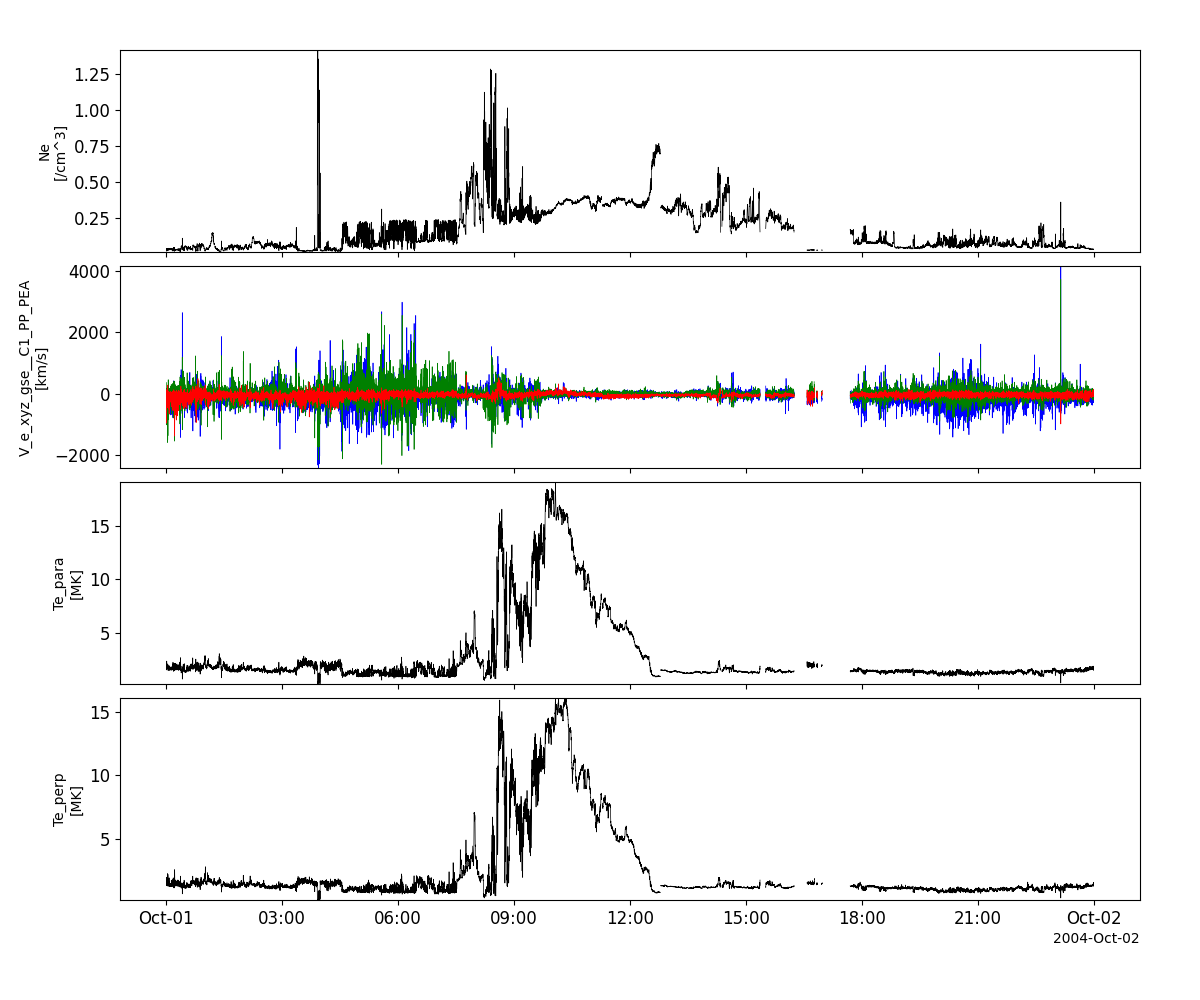
Research with Adaptive Particle Imaging Detectors (RAPID)
- pyspedas.cluster.rapid(trange=['2016-11-5', '2016-11-6'], probe='1', datatype='pp', suffix='', get_support_data=False, varformat=None, varnames=[], downloadonly=False, notplot=False, no_update=False, time_clip=False)
This function loads data from the Research with Adaptive Particle Imaging Detectors
- Parameters
trange – list of str time range of interest [starttime, endtime] with the format ‘YYYY-MM-DD’,’YYYY-MM-DD’] or to specify more or less than a day [‘YYYY-MM-DD/hh:mm:ss’,’YYYY-MM-DD/hh:mm:ss’]
datatype – str Data type; Valid options:
suffix – str The tplot variable names will be given this suffix. By default, no suffix is added.
get_support_data – bool Data with an attribute “VAR_TYPE” with a value of “support_data” will be loaded into tplot. By default, only loads in data with a “VAR_TYPE” attribute of “data”.
varformat – str The file variable formats to load into tplot. Wildcard character “*” is accepted. By default, all variables are loaded in.
varnames – list of str List of variable names to load (if not specified, all data variables are loaded)
downloadonly – bool Set this flag to download the CDF files, but not load them into tplot variables
notplot – bool Return the data in hash tables instead of creating tplot variables
no_update – bool If set, only load data from your local cache
time_clip – bool Time clip the variables to exactly the range specified in the trange keyword
- Returns
List of tplot variables created.
Example
import pyspedas
from pytplot import tplot
rap_vars = pyspedas.cluster.rapid(trange=['2004-10-01', '2004-10-2'])
tplot(['J_e_lo__C1_PP_RAP', 'J_e_hi__C1_PP_RAP', 'J_p_lo__C1_PP_RAP', 'J_p_hi__C1_PP_RAP'])
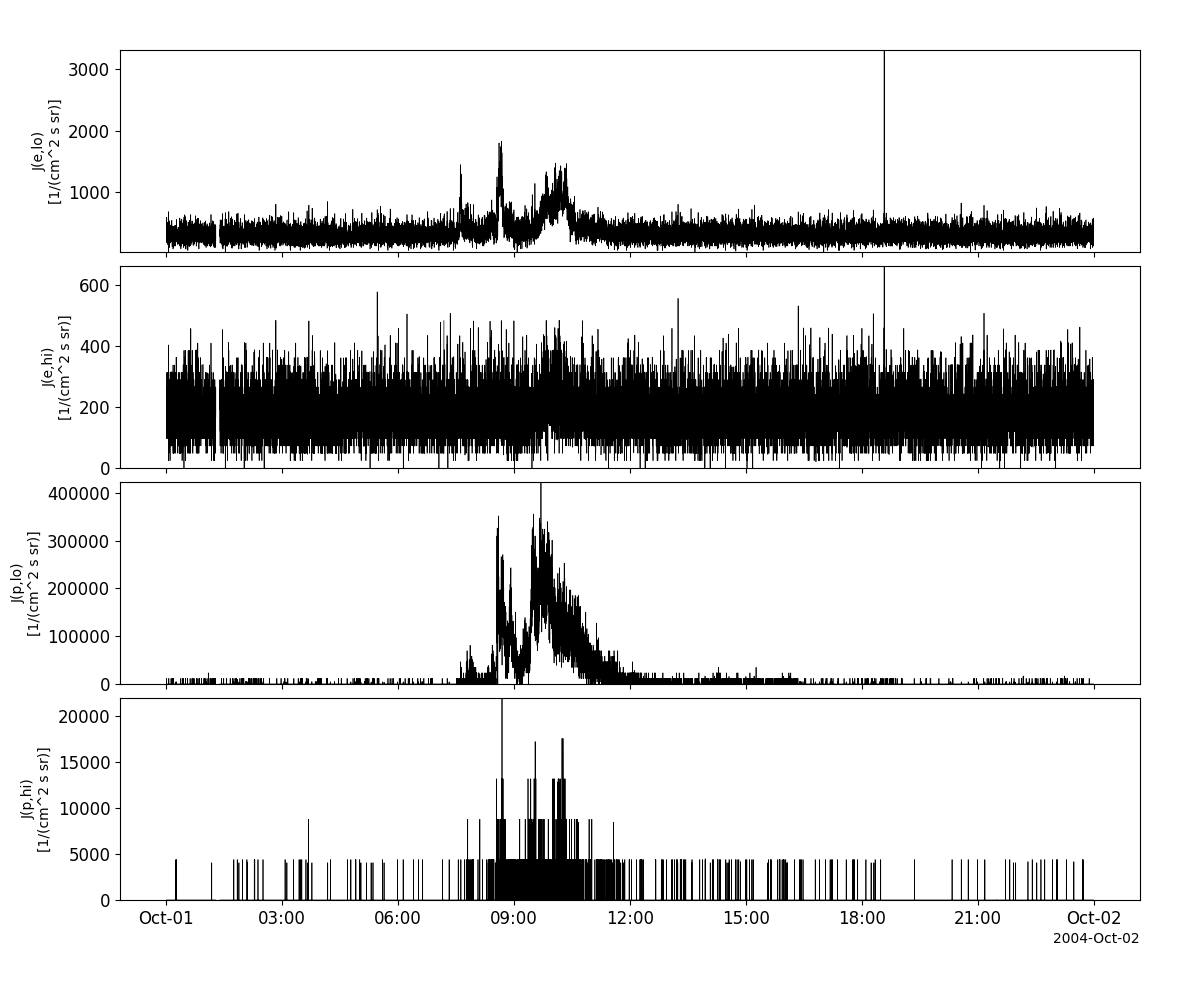
Spatio-Temporal Analysis of Field Fluctuation experiment (STAFF)
- pyspedas.cluster.staff(trange=['2012-11-5', '2012-11-6'], probe='1', datatype='pp', suffix='', get_support_data=False, varformat=None, varnames=[], downloadonly=False, notplot=False, no_update=False, time_clip=False)
This function loads data from the Spatio-Temporal Analysis of Field Fluctuation experiment
- Parameters
trange – list of str time range of interest [starttime, endtime] with the format ‘YYYY-MM-DD’,’YYYY-MM-DD’] or to specify more or less than a day [‘YYYY-MM-DD/hh:mm:ss’,’YYYY-MM-DD/hh:mm:ss’]
datatype – str Data type; Valid options:
suffix – str The tplot variable names will be given this suffix. By default, no suffix is added.
get_support_data – bool Data with an attribute “VAR_TYPE” with a value of “support_data” will be loaded into tplot. By default, only loads in data with a “VAR_TYPE” attribute of “data”.
varformat – str The file variable formats to load into tplot. Wildcard character “*” is accepted. By default, all variables are loaded in.
varnames – list of str List of variable names to load (if not specified, all data variables are loaded)
downloadonly – bool Set this flag to download the CDF files, but not load them into tplot variables
notplot – bool Return the data in hash tables instead of creating tplot variables
no_update – bool If set, only load data from your local cache
time_clip – bool Time clip the variables to exactly the range specified in the trange keyword
- Returns
List of tplot variables created.
Example
import pyspedas
from pytplot import tplot
sta_vars = pyspedas.cluster.staff(trange=['2004-10-01', '2004-10-02'])
tplot('B_par_f1__C1_PP_STA')
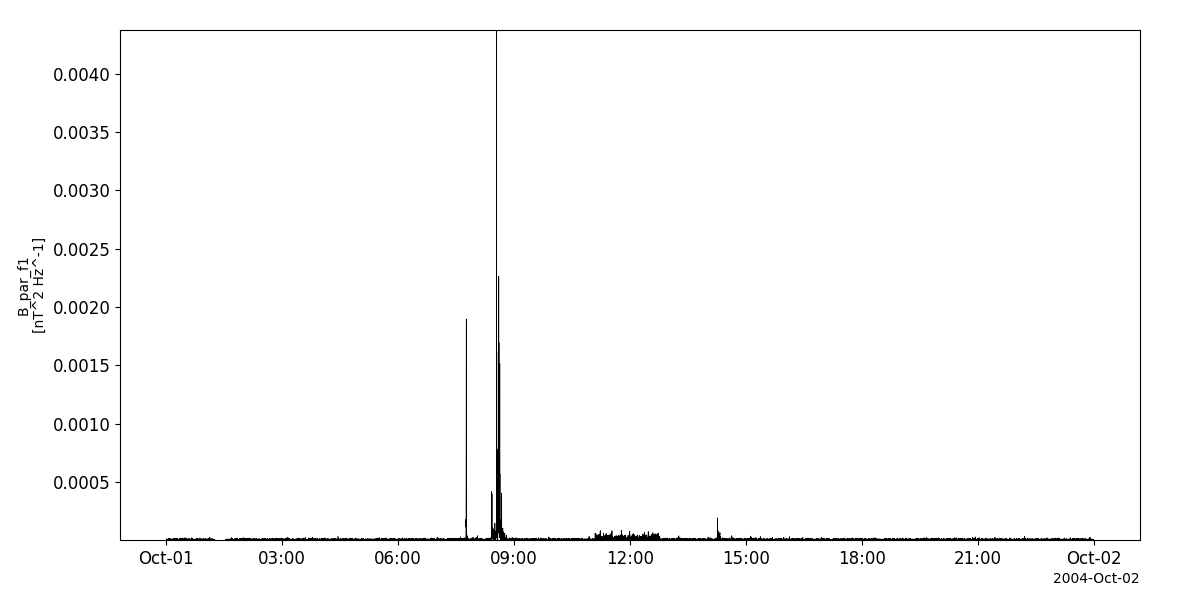
Wide Band Data receiver (WBD)
- pyspedas.cluster.wbd(trange=['2012-11-6', '2012-11-7'], probe='1', datatype='waveform', suffix='', get_support_data=False, varformat=None, varnames=[], downloadonly=False, notplot=False, no_update=False, time_clip=False)
This function loads data from the Wide Band Data receiver
- Parameters
trange – list of str time range of interest [starttime, endtime] with the format ‘YYYY-MM-DD’,’YYYY-MM-DD’] or to specify more or less than a day [‘YYYY-MM-DD/hh:mm:ss’,’YYYY-MM-DD/hh:mm:ss’]
datatype – str Data type; Valid options:
suffix – str The tplot variable names will be given this suffix. By default, no suffix is added.
get_support_data – bool Data with an attribute “VAR_TYPE” with a value of “support_data” will be loaded into tplot. By default, only loads in data with a “VAR_TYPE” attribute of “data”.
varformat – str The file variable formats to load into tplot. Wildcard character “*” is accepted. By default, all variables are loaded in.
varnames – list of str List of variable names to load (if not specified, all data variables are loaded)
downloadonly – bool Set this flag to download the CDF files, but not load them into tplot variables
notplot – bool Return the data in hash tables instead of creating tplot variables
no_update – bool If set, only load data from your local cache
time_clip – bool Time clip the variables to exactly the range specified in the trange keyword
- Returns
List of tplot variables created.
Example
import pyspedas
from pytplot import tplot
wbd_vars = pyspedas.cluster.wbd(trange=['2012-11-06/02:10', '2012-11-06/02:20'])
tplot('WBD_Elec')
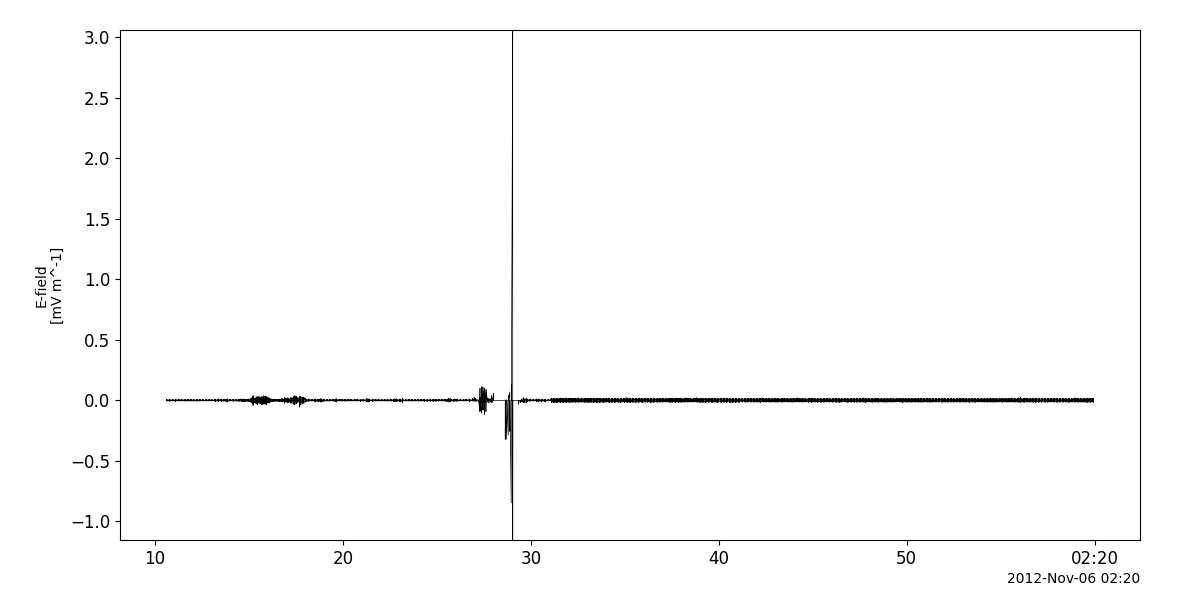
Waves of High Frequency and Sounder for Probing of Density by Relaxation (WHISPER)
- pyspedas.cluster.whi(trange=['2012-11-5', '2012-11-6'], probe='1', datatype='pp', suffix='', get_support_data=False, varformat=None, varnames=[], downloadonly=False, notplot=False, no_update=False, time_clip=False)
This function loads data from the Waves of High Frequency and Sounder for Probing of Density by Relaxation instrument
- Parameters
trange – list of str time range of interest [starttime, endtime] with the format ‘YYYY-MM-DD’,’YYYY-MM-DD’] or to specify more or less than a day [‘YYYY-MM-DD/hh:mm:ss’,’YYYY-MM-DD/hh:mm:ss’]
datatype – str Data type; Valid options:
suffix – str The tplot variable names will be given this suffix. By default, no suffix is added.
get_support_data – bool Data with an attribute “VAR_TYPE” with a value of “support_data” will be loaded into tplot. By default, only loads in data with a “VAR_TYPE” attribute of “data”.
varformat – str The file variable formats to load into tplot. Wildcard character “*” is accepted. By default, all variables are loaded in.
varnames – list of str List of variable names to load (if not specified, all data variables are loaded)
downloadonly – bool Set this flag to download the CDF files, but not load them into tplot variables
notplot – bool Return the data in hash tables instead of creating tplot variables
no_update – bool If set, only load data from your local cache
time_clip – bool Time clip the variables to exactly the range specified in the trange keyword
- Returns
List of tplot variables created.
Example
import pyspedas
from pytplot import tplot
whi_vars = pyspedas.cluster.whi()
tplot('N_e_res__C1_PP_WHI')
